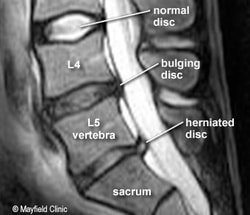Discs don’t slip!
Lower back pain is the number 1 reason for loss of work productivity and early retirement - which is absolutely crazy, considering that it’s an injury that 70-80% of adults will experience at some point in their life. Naturally, it’s the single greatest cause of disability worldwide, and costs the Australian health system a whopping $4.8 billion each year [1].
And so, it’s no wonder that one of the most common questions that we get asked with acute/sudden lower back pain is -
“Have I slipped my disc?”
Most people tend to think of discs as delicate, fragile things in our spine that can slip out of place - and once that happens, it’s there for life. We’ve all been told a story by someone we know about how they lifted something the wrong way back X number of years ago, and bang, slipped a disc, and hasn’t ever been able to get it back since. They saw someone for X amount of time who shoved it back in, but every few years/month it slips back out again (sometimes worse than others). Sound familiar? (I’m looking at you, dad.).
Why discs can’t slip.
Every disc in your back forms a joint between the bony segment above and below it. You might have heard the term “C2” or “L4/5” thrown around before, referring to the specific bone/joint in each part of the back - C for Cervical, T for Thoracic, L for Lumbar, and S for Sacrum.
This joint that is created is known as a symphysis, which is a type of joint that is incredibly strong - it’s the same joint that holds the sternum together. That’s right, the place where you do CPR on, and yet instead of that joint breaking, the ribs break instead (commonly).
Not only is this intervertebral “disc” joint incredibly strong and not slipping anywhere, but it’s also incredibly resistant to compression and tensile forces. A study in 2010 [2] showed that thoracic discs in a cadaver could take 335kg in a 28 year old, and 208kg in a 70 year old - and this isn’t even including muscles helping with managing the load.
So discs can’t slip. They’re incredibly strong and resistant to load, and they are firmly anchored onto the bones that they’re joining together. But they can get injured, and this is what you might sometimes see from an MRI report - showing a disc protrusion, herniation, extrusion, or sequestration.
Isn’t this just semantics then? Disc herniation, bulge, protrusion or slip - is there really a difference?
Well, part of the issue of using the word “slipped disc” is the connotation it has - the thought that the back has now become a fragile structure, in serious need of attention, monitoring, and concentration otherwise a disc might slip out from between our spine (not unlike slipping on a banana peel in Mario Kart).
Too often we see people, who are so afraid of their “slipped disc” that they’re unwilling to move, or get back to any physical activity - as though they are one step away from catastrophic damage.
There is a large amount of evidence that shows that in most cases the bulging, herniated, protruding disc is reabsorbed spontaneously by the body [3]. We’re seeing more and more in the world of medicine, that there is a high rate of disc bulges that reduce over time if people continue to move and focus on other lifestyle factors.
So, we need to stop over-respecting the pain that we have in our backs and cowering in fear that at any point in time our discs might suddenly slip out. It’s more than just about changing the terminology we use, it’s changing the way we think and approach lower back pain!
If back pain is something you have been experiencing for a while or if you have any further questions, feel free to book an appointment online with one of our physiotherapists at https://elevation-one.com.au/booknow.
This blog and the contents within are shared to enrich the understanding that members of the Elevation One community have in relation to physiotherapy and general health. It should not be used to diagnose any medical conditions and is not health advice. We always recommend seeking a medical professional for your health concerns.
[1] Arthritis and Osteoporosis Victoria. (2013). A Problem Worth Solving: The Rising Cost of Musculoskeletal Conditions in Australia: a Report. Arthritis and Osteoporosis Victoria. Soft copy be found here.
[2] Stemper, B. D., Board, D., Yoganandan, N., & Wolfla, C. E. (2010). Biomechanical properties of human thoracic spine disc segments. Journal of craniovertebral junction & spine, 1(1), 18–22. Soft copy can be found here.
[3] Zhong, M., Liu, J. T., Jiang, H., Mo, W., Yu, P. F., Li, X. C., & Xue, R. R. (2017). Incidence of Spontaneous Resorption of Lumbar Disc Herniation: A Meta-Analysis. Pain physician, 20(1), E45–E52. Soft copy can be found here.




